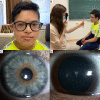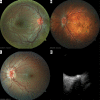Neuro-Ophthalmological Manifestations in Children with Down Syndrome: Current Perspectives
- PMID: 34321946
- PMCID: PMC8311006
- DOI: 10.2147/EB.S319817
Neuro-Ophthalmological Manifestations in Children with Down Syndrome: Current Perspectives
Abstract
Down syndrome, caused by an extra copy of all or part of chromosome 21, is the most prevalent intellectual disability of genetic origin. Among numerous comorbidities which are part of the phenotype of individuals with Down syndrome, ocular problems appear to be highly prevalent. Neuro-ophthalmological manifestations, such as ocular alignment and motility disturbances, amblyopia, hypoaccommodation or optic nerve abnormalities, and other organic ocular anomalies frequently reported in Down syndrome, may lead to an overall decrease in visual acuity. Although numerous studies have reported ocular anomalies related to Down syndrome, it remains challenging to determine the impact of each anomaly upon the decreased visual acuity, as most such individuals have more than one ocular problem. Even in children with Down syndrome and no apparent ocular defect, visual acuity has been found to be reduced compared with typically developing children. Pediatric ophthalmological examination is a critical component of a multidisciplinary approach to prevent and treat ocular complications and improve the visual outcome in children with Down syndrome. This narrative review aims to provide a better understanding of the neuro-ophthalmological manifestations and discuss the current ophthalmological management in children with Down syndrome.
Keywords: Down syndrome; hypoaccommodation; nystagmus; ocular anomalies; optic nerve; pediatric ophthalmology; strabismus; trisomy 21.
© 2021 Postolache et al.
Conflict of interest statement
The authors report no conflicts of interest in this work.
Figures


Similar articles
-
Down syndrome: a review of ocular manifestations.Ther Adv Ophthalmol. 2022 Jun 30;14:25158414221101718. doi: 10.1177/25158414221101718. eCollection 2022 Jan-Dec. Ther Adv Ophthalmol. 2022. PMID: 35795721 Free PMC article. Review.
-
Abnormalities of the Optic Nerve in Down Syndrome and Associations With Visual Acuity.Front Neurol. 2019 Jun 14;10:633. doi: 10.3389/fneur.2019.00633. eCollection 2019. Front Neurol. 2019. PMID: 31258511 Free PMC article.
-
Ophthalmologic and neuro-ophthalmologic findings in children with Down syndrome.Am J Med Genet C Semin Med Genet. 2023 Dec;193(4):e32068. doi: 10.1002/ajmg.c.32068. Epub 2023 Oct 4. Am J Med Genet C Semin Med Genet. 2023. PMID: 37794641 Review.
-
Ocular findings in Noonan syndrome: a retrospective cohort study of 105 patients.Eur J Pediatr. 2018 Aug;177(8):1293-1298. doi: 10.1007/s00431-018-3183-1. Epub 2018 Jun 9. Eur J Pediatr. 2018. PMID: 29948256 Free PMC article.
-
A Review of Neuro-Ophthalmological Manifestations of Human Coronavirus Infection.Eye Brain. 2020 Oct 30;12:129-137. doi: 10.2147/EB.S268828. eCollection 2020. Eye Brain. 2020. PMID: 33154692 Free PMC article. Review.
Cited by
-
Down syndrome: a review of ocular manifestations.Ther Adv Ophthalmol. 2022 Jun 30;14:25158414221101718. doi: 10.1177/25158414221101718. eCollection 2022 Jan-Dec. Ther Adv Ophthalmol. 2022. PMID: 35795721 Free PMC article. Review.
-
Association of plasma neurofilament light chain with microstructural white matter changes in Down syndrome.Alzheimers Dement (Amst). 2024 Nov 22;16(4):e70023. doi: 10.1002/dad2.70023. eCollection 2024 Oct-Dec. Alzheimers Dement (Amst). 2024. PMID: 39583646 Free PMC article.
-
Prevalence and etiology of strabismus in Down syndrome: A systematic review and meta-analysis with a focus on ethnic differences in the esotropia/exotropia ratio.medRxiv [Preprint]. 2025 Apr 23:2024.11.28.24318156. doi: 10.1101/2024.11.28.24318156. medRxiv. 2025. Update in: Ophthalmic Epidemiol. 2025 Jun 3:1-19. doi: 10.1080/09286586.2025.2500018. PMID: 39649585 Free PMC article. Updated. Preprint.
-
Prevalence and Etiology of Strabismus in Down Syndrome: A Systematic Review and Meta-Analysis with a Focus on Ethnic Differences in the Esotropia/Exotropia Ratio.Ophthalmic Epidemiol. 2025 Jun 3:1-19. doi: 10.1080/09286586.2025.2500018. Online ahead of print. Ophthalmic Epidemiol. 2025. PMID: 40458862 Review.
-
Trisomy 21 and Congenital Heart Disease: Impact on Health and Functional Outcomes From Birth Through Adolescence: A Scientific Statement From the American Heart Association.J Am Heart Assoc. 2024 Oct;13(19):e036214. doi: 10.1161/JAHA.124.036214. Epub 2024 Sep 12. J Am Heart Assoc. 2024. PMID: 39263820 Free PMC article. Review.
References
-
- Contestabile A, Benfenati F, Gasparini L. Communication breaks-Down: from neurodevelopment defects to cognitive disabilities in Down syndrome. Prog Neurobiol. 2010;91(1):1–22. - PubMed
Publication types
LinkOut - more resources
Full Text Sources

